Abstract
OBJECTIVES: Exposure to the radioactive daughters of radon is associated with increased risk of lung cancer in mining populations. An investigation of incidence of lung cancer following a clinical survey of Ontario uranium miners was undertaken to explore whether risk associated with radon is modified by factors including smoking, radiographic silicosis, clinical symptoms, the results of lung function testing, and the temporal pattern of radon exposure. METHODS: Miners were examined in 1974 by a respiratory questionnaire, tests of lung function, and chest radiography. A random selection of 733 (75%) of the original 973 participants was followed up by linkage to the Ontario Mortality and Cancer Registries. RESULTS: Incidence of lung cancer was increased threefold. Risk of lung cancer among miners who had stopped smoking was half that of men who continued to smoke. There was no interaction between smoking and radon exposure. Men with lung function test results consistent with airways obstruction had an increased risk of lung cancer, even after adjustment for cigarette smoking. There was no association between radiographic silicosis and risk of lung cancer. Lung cancer was associated with exposures to radon daughters accumulated in a time window four to 14 years before diagnosis, but there was little association with exposures incurred earlier than 14 years before diagnosis. Among the men diagnosed with lung cancer, the mean and median dose rates were 2.6 working level months (WLM) a year and 1.8 WLM/year in the four to 14 year exposure window. CONCLUSIONS: Risk of lung cancer associated with radon is modified by dose and time from exposure. Risk can be substantially decreased by stopping smoking.
Full text
PDF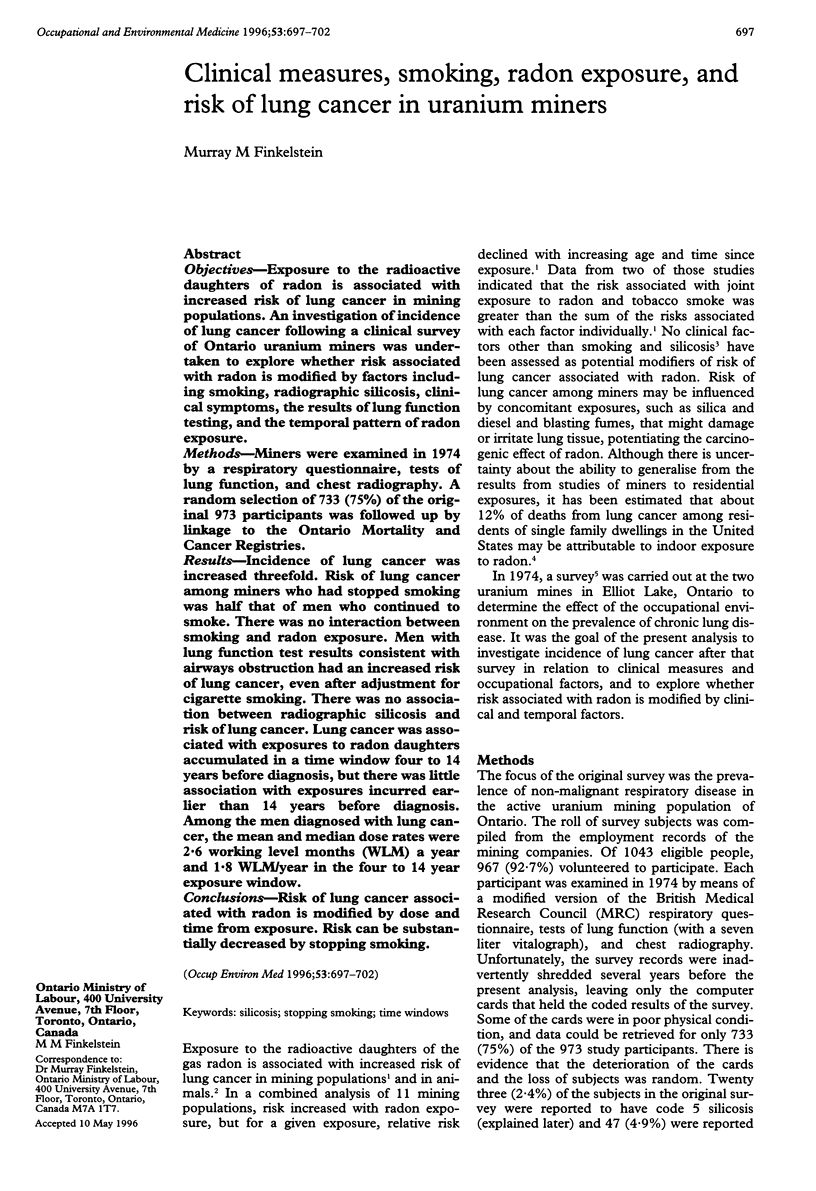
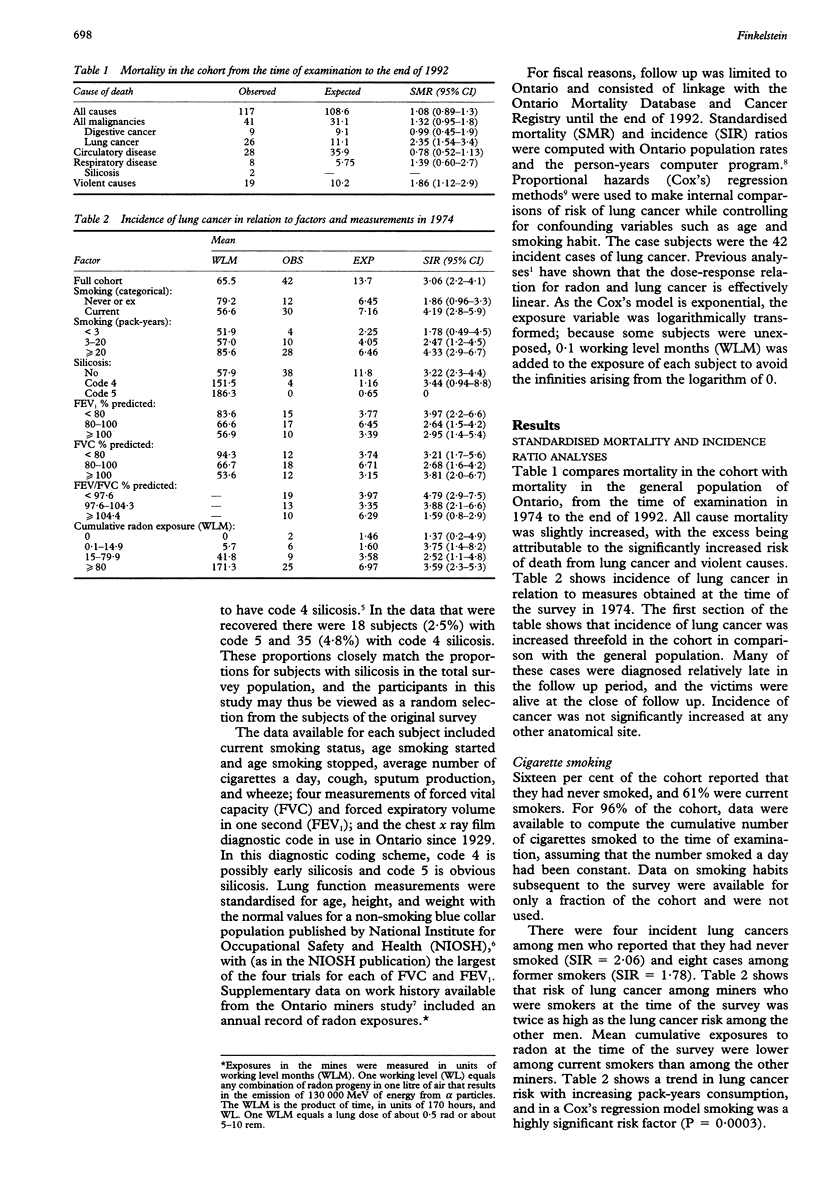
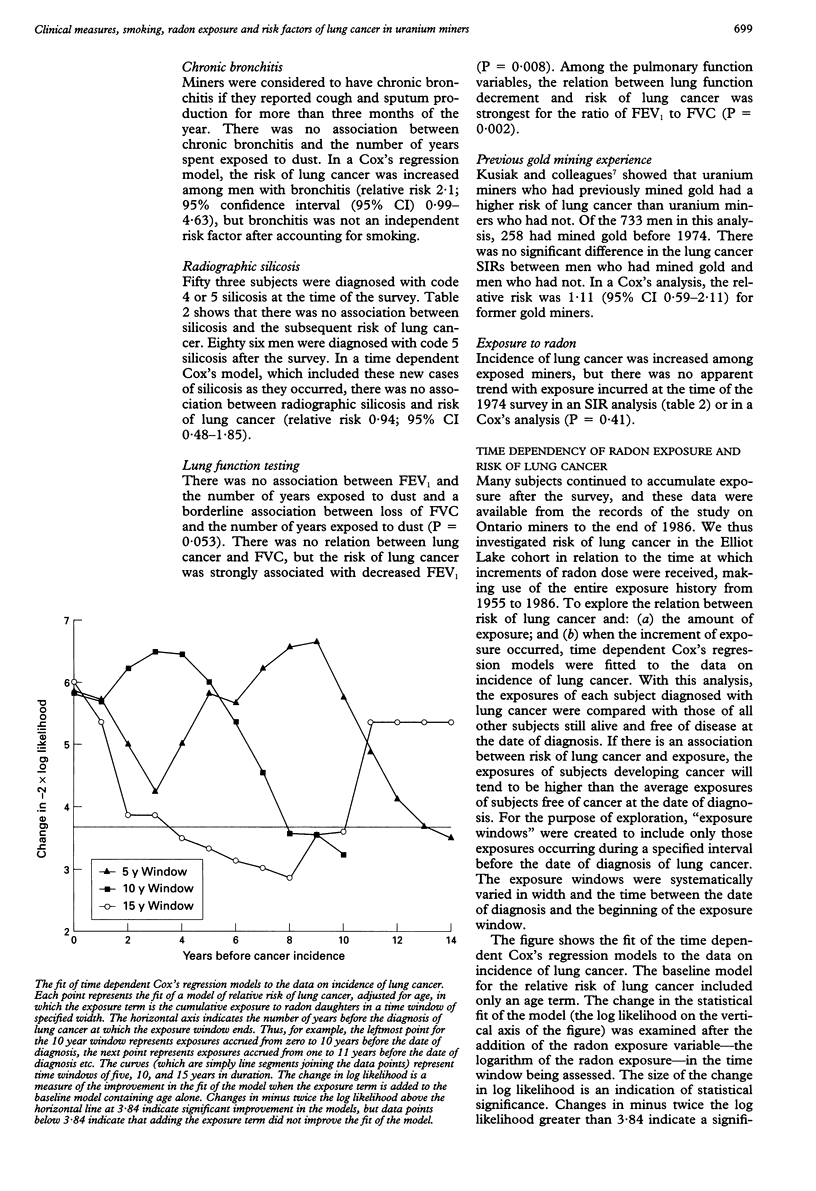

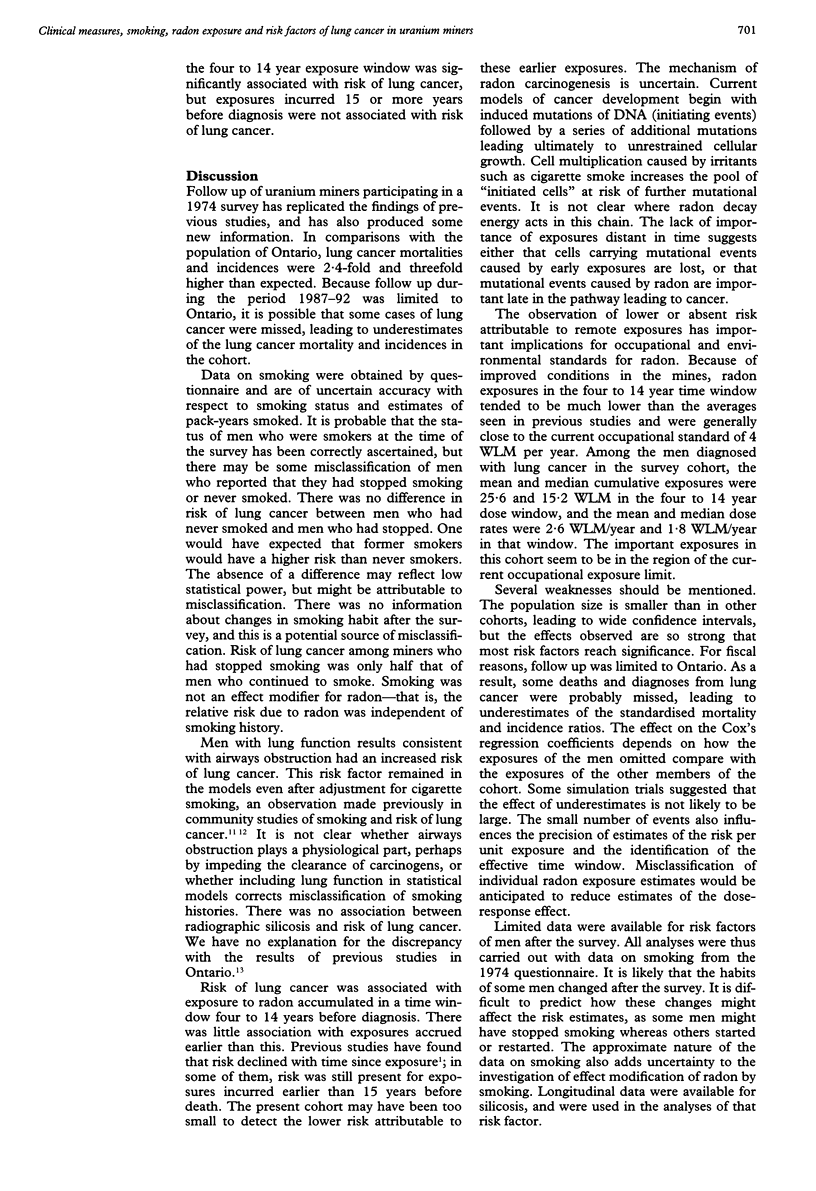
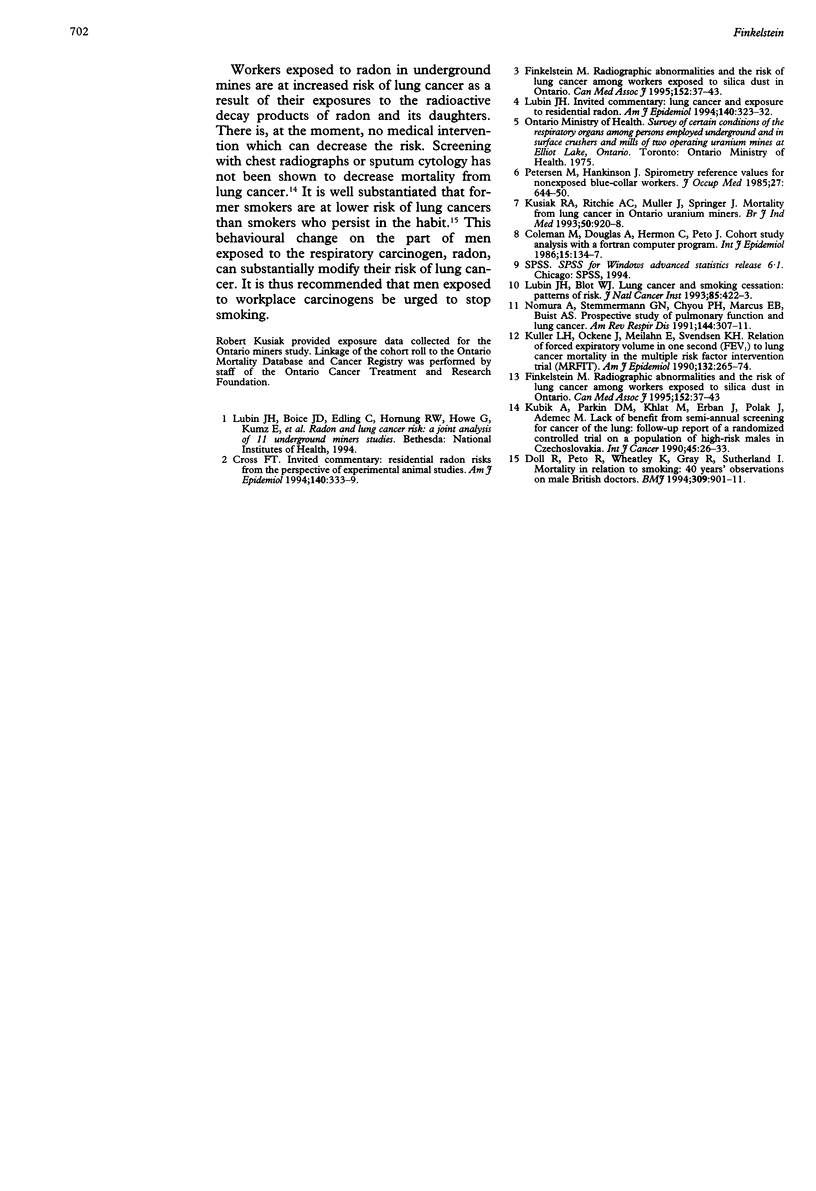
Selected References
These references are in PubMed. This may not be the complete list of references from this article.
- Coleman M., Douglas A., Hermon C., Peto J. Cohort study analysis with a FORTRAN computer program. Int J Epidemiol. 1986 Mar;15(1):134–137. doi: 10.1093/ije/15.1.134. [DOI] [PubMed] [Google Scholar]
- Cross F. T. Invited commentary: residential radon risks from the perspective of experimental animal studies. Am J Epidemiol. 1994 Aug 15;140(4):333–339. doi: 10.1093/oxfordjournals.aje.a117255. [DOI] [PubMed] [Google Scholar]
- Doll R., Peto R., Wheatley K., Gray R., Sutherland I. Mortality in relation to smoking: 40 years' observations on male British doctors. BMJ. 1994 Oct 8;309(6959):901–911. doi: 10.1136/bmj.309.6959.901. [DOI] [PMC free article] [PubMed] [Google Scholar]
- Finkelstein M. M. Radiographic abnormalities and the risk of lung cancer among workers exposed to silica dust in Ontario. CMAJ. 1995 Jan 1;152(1):37–43. [PMC free article] [PubMed] [Google Scholar]
- Finkelstein M. M. Radiographic abnormalities and the risk of lung cancer among workers exposed to silica dust in Ontario. CMAJ. 1995 Jan 1;152(1):37–43. [PMC free article] [PubMed] [Google Scholar]
- Kubik A., Parkin D. M., Khlat M., Erban J., Polak J., Adamec M. Lack of benefit from semi-annual screening for cancer of the lung: follow-up report of a randomized controlled trial on a population of high-risk males in Czechoslovakia. Int J Cancer. 1990 Jan 15;45(1):26–33. doi: 10.1002/ijc.2910450107. [DOI] [PubMed] [Google Scholar]
- Kuller L. H., Ockene J., Meilahn E., Svendsen K. H. Relation of forced expiratory volume in one second (FEV1) to lung cancer mortality in the Multiple Risk Factor Intervention Trial (MRFIT). Am J Epidemiol. 1990 Aug;132(2):265–274. doi: 10.1093/oxfordjournals.aje.a115656. [DOI] [PubMed] [Google Scholar]
- Kusiak R. A., Ritchie A. C., Muller J., Springer J. Mortality from lung cancer in Ontario uranium miners. Br J Ind Med. 1993 Oct;50(10):920–928. doi: 10.1136/oem.50.10.920. [DOI] [PMC free article] [PubMed] [Google Scholar]
- Lubin J. H., Blot W. J. Lung cancer and smoking cessation: patterns of risk. J Natl Cancer Inst. 1993 Mar 17;85(6):422–423. doi: 10.1093/jnci/85.6.422. [DOI] [PubMed] [Google Scholar]
- Lubin J. H. Invited commentary: lung cancer and exposure to residential radon. Am J Epidemiol. 1994 Aug 15;140(4):323–332. doi: 10.1093/oxfordjournals.aje.a117254. [DOI] [PubMed] [Google Scholar]
- Nomura A., Stemmermann G. N., Chyou P. H., Marcus E. B., Buist A. S. Prospective study of pulmonary function and lung cancer. Am Rev Respir Dis. 1991 Aug;144(2):307–311. doi: 10.1164/ajrccm/144.2.307. [DOI] [PubMed] [Google Scholar]
- Petersen M., Hankinson J. Spirometry reference values for nonexposed blue-collar workers. J Occup Med. 1985 Sep;27(9):644–650. [PubMed] [Google Scholar]


